2020年广州教科版英语三年级下册重点知识Unit 1 I like red
- 格式:docx
- 大小:524.88 KB
- 文档页数:4
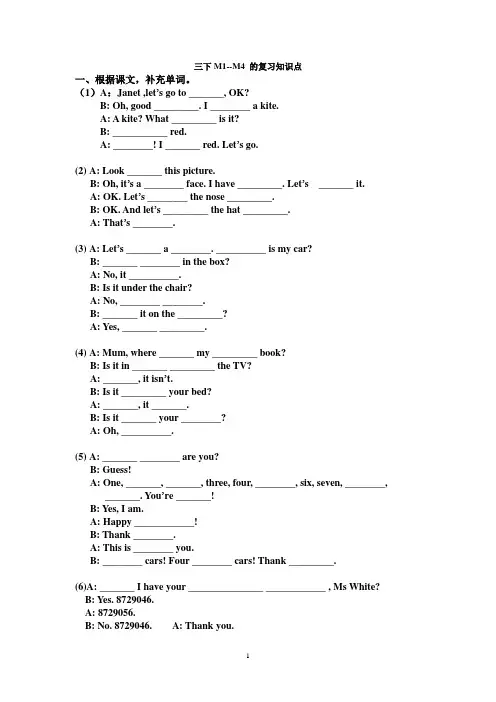
三下M1--M4 的复习知识点一、根据课文,补充单词。
(1)A:Janet ,let’s go to _______, OK?B: Oh, good _________. I ________ a kite.A: A kite? What _________ is it?B: ___________ red.A: ________! I _______ red. Let’s go.(2)A: Look _______ this picture.B: Oh, it’s a ________ face. I have _________. Let’s _______ it.A: OK. Let’s ________ the nose _________.B: OK. And let’s _________ the hat _________.A: That’s ________.(3)A: Let’s _______ a ________. __________ is my car?B: _______ ________ in the box?A: No, it __________.B: Is it under the chair?A: No, ________ ________.B: _______ it on the _________?A: Yes, _______ _________.(4)A: Mum, where _______ my _________ book?B: Is it in _______ _________ the TV?A: _______, it isn’t.B: Is it _________ your bed?A: _______, it _______.B: Is it _______ your ________?A: Oh, __________.(5)A: _______ ________ are you?B: Guess!A: One, _______, _______, three, four, ________, six, seven, ________, _______. You’re _______!B: Yes, I am.A: Happy ____________!B: Thank ________.A: This is ________ you.B: ________ cars! Four ________ cars! Thank _________.(6)A: _______ I have your _______________ ____________ , Ms White? B: Yes. 8729046.A: 8729056.B: No. 8729046. A: Thank you.(7)A: I ________ a ___________, Mum. Do we have ____________?B: No, we _________. But we have ________ _________.A: I like ________. _______ I have _________ _________, then?B: Yes. ________ you ________.A: _________ you, Mum.(8)A: _______ I have some _______, Mum?B: Of __________. What _________ do you like? Some apples?A: OK. Mum. Apples are _______ ________ us.B: Let’s get six _________, two ________ you, two_______ dad and two _____ ________.A: And some __________, too. I like ___________.B: OK.二、判断下列单词划线部分是否发音一致,用“T”或“F”表示。
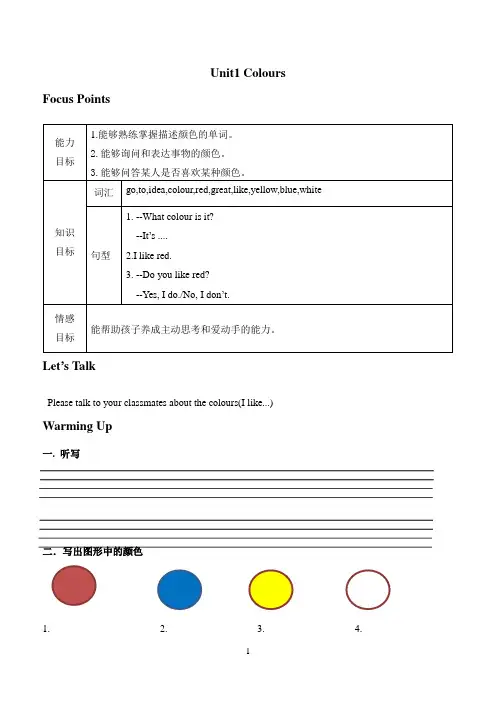
Unit1 ColoursFocus PointsLet ’s TalkPlease talk to your classmates about the colours(I like...)Warming Up一. 听写二.写出图形中的颜色1._______2._______3._______4._______三. 课文内容根据提示把句子补充完整。
A:Janet,Let’s ____ ____ ____,OK?B:Oh,____ ____.I have a kite.A:A kite?What ____ is it?B: It’s ____.A:____ I like red.Let’s go.Language Points【知识考点一】What colour is it? -- It’s red. 它是什么颜色的? 它是红色的。
【句型结构】问句:What colour + be动词+主语(the pen,they...)?答语:It’s /They’re +颜色(red,blue...)此问句用于询问物品的颜色。
What colour意为“什么颜色”。
*注意:当主语是单数形式时,be动词用is;当主语是复数形式时,be动词用are。
【试试看】( )________ ________is a panda?-- It’s black and white.A. What timeB.What colour【知识考点二】I like red. 我喜欢红色。
【句型结构】I like + 某人/某物(my mother, story books...).此句型用于表达自己的喜好。
Like在这里是动词,意为“喜欢”。
【试试看】( )I ________ hamburgers.A. LikeB. am【知识考点三】Do you like red? -- No, I don’t. 你喜欢红色吗?不,我不喜欢。
【句型结构】问句:Do you like + 某人/某物(your sister,apples...)?答句:Yes,I/we do./No,I/we don’t.此问句用于询问对方是否喜欢某人或某物。
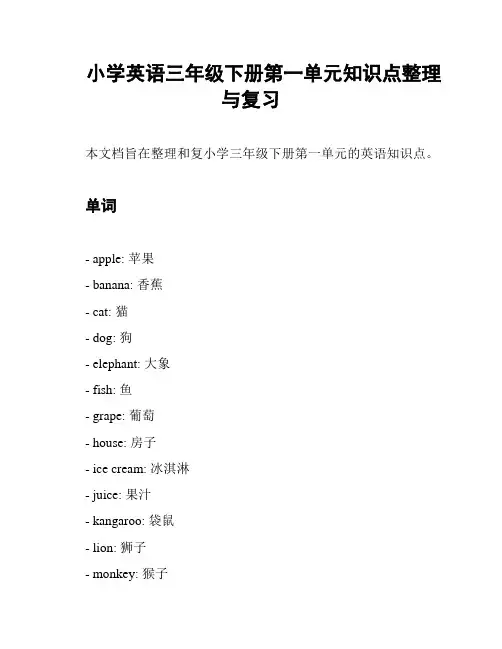
小学英语三年级下册第一单元知识点整理与复习本文档旨在整理和复小学三年级下册第一单元的英语知识点。
单词- apple: 苹果- banana: 香蕉- cat: 猫- dog: 狗- elephant: 大象- fish: 鱼- grape: 葡萄- house: 房子- ice cream: 冰淇淋- juice: 果汁- kangaroo: 袋鼠- lion: 狮子- monkey: 猴子- nurse: 护士- orange: 橙子- pig: 猪- queen: 女王- rabbit: 兔子- snake: 蛇- tiger: 老虎- umbrella: 雨伞- van: 货车- watch: 手表- xylophone: 木琴- yo-yo: 溜溜球- zebra: 斑马句子1. I have an apple.(我有一个苹果。
)2. Do you like bananas?(你喜欢香蕉吗?)3. The cat is sleeping.(猫在睡觉。
)4. The dog is running.(狗在跑。
)5. The elephant is big.(大象很大。
)6. The fish is swimming.(鱼在游泳。
)7. I like grapes.(我喜欢葡萄。
)8. This is my house.(这是我的房子。
)9. I want ice cream.(我想要冰淇淋。
)10. I drink juice.(我喝果汁。
)11. The kangaroo is jumping.(袋鼠在跳。
)12. The lion is roaring.(狮子在吼。
)13. The monkey is swinging.(猴子在荡秋千。
)14. The nurse is helping.(护士在帮助。
)15. I like oranges.(我喜欢橙子。
)16. The pig is rolling in the mud.(猪在泥里打滚。
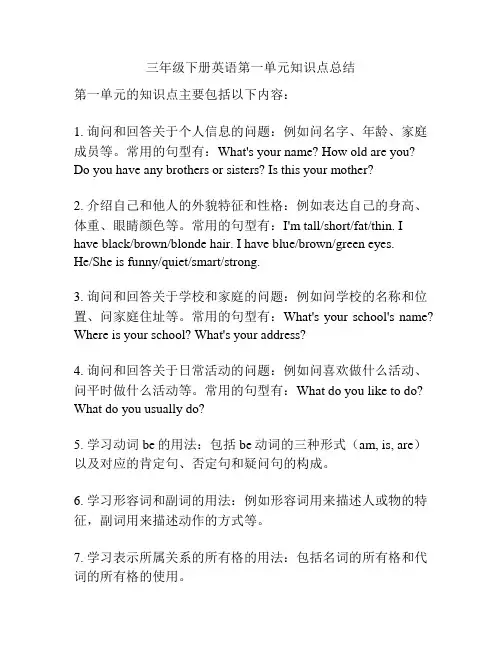
三年级下册英语第一单元知识点总结第一单元的知识点主要包括以下内容:1. 询问和回答关于个人信息的问题:例如问名字、年龄、家庭成员等。
常用的句型有:What's your name? How old are you? Do you have any brothers or sisters? Is this your mother?2. 介绍自己和他人的外貌特征和性格:例如表达自己的身高、体重、眼睛颜色等。
常用的句型有:I'm tall/short/fat/thin. I have black/brown/blonde hair. I have blue/brown/green eyes.He/She is funny/quiet/smart/strong.3. 询问和回答关于学校和家庭的问题:例如问学校的名称和位置、问家庭住址等。
常用的句型有:What's your school's name? Where is your school? What's your address?4. 询问和回答关于日常活动的问题:例如问喜欢做什么活动、问平时做什么活动等。
常用的句型有:What do you like to do? What do you usually do?5. 学习动词be的用法:包括be动词的三种形式(am, is, are)以及对应的肯定句、否定句和疑问句的构成。
6. 学习形容词和副词的用法:例如形容词用来描述人或物的特征,副词用来描述动作的方式等。
7. 学习表示所属关系的所有格的用法:包括名词的所有格和代词的所有格的使用。
这些是第一单元的主要知识点,通过学习和掌握这些知识点,可以提升对英语的理解和运用能力。
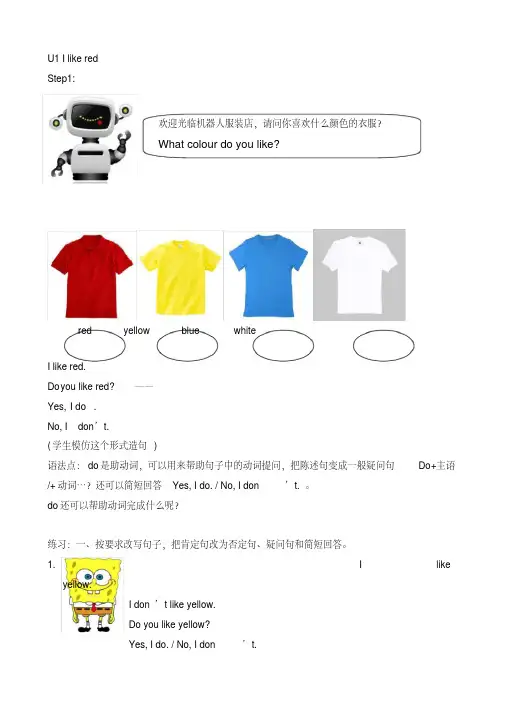
U1 I like redStep1:欢迎光临机器人服装店,请问你喜欢什么颜色的衣服?What colour do you like?red yellow blue whiteI like red.Do you like red? ——Yes, I do.No, I don’t.(学生模仿这个形式造句)语法点:do是助动词,可以用来帮助句子中的动词提问,把陈述句变成一般疑问句Do +主语/+动词…?还可以简短回答Yes, I do. / No, I don’t.。
do还可以帮助动词完成什么呢?练习:一、按要求改写句子,把肯定句改为否定句、疑问句和简短回答。
1. I likeyellow.I don’t like yellow.Do you like yellow?Yes, I do. / No, I don’t.2,3.4.do还可以用于构成否定句:主语+don’t+动词。
二、仿照例子写句子。
I have a blue car.I don’t have a blue car.Do you have a blue car?根据实际回答:Yes, I do. / No, I don’t.三、按要求改写句子。
1.把肯定句变一般疑问句I have a red car.2.把肯定句变一般疑问句I like blue.3.把否定句变成肯定句I don’t have a white cat.4.把疑问句变成肯定句Do you have a dog?5.根据实际情况进行简短回答Do you have brothers or sisters?6.根据实际情况进行简短回答Do you like yellow?总结: do 是助动词,无特别意思。
如果一个句子含有实义动词,那么当它变成疑问句、否定句和简短回答的时候就要使用助动词do。
在回答Do you like…?和Do you have…? 的时候用Yes, I do. /No, I don’t.U2 Let’s colour itStep1:下图的人脸缺少了什么?请把缺少的部分画上,在只有一个的名词前面加a,在两个或两个以上的名词后面加s。
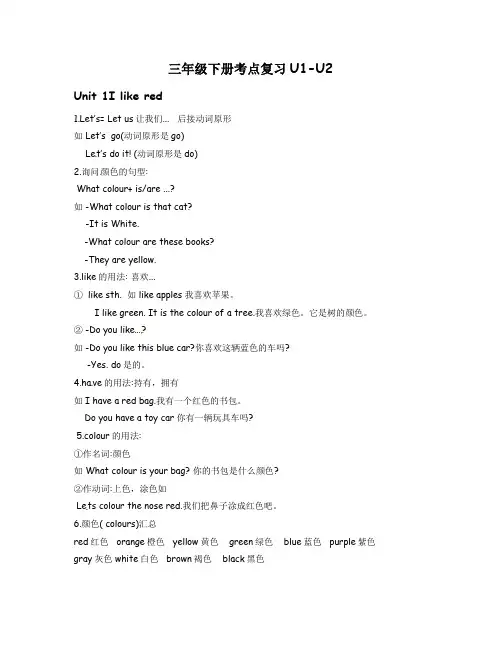
三年级下册考点复习U1-U2
Unit 1I like red
1.Le t’s= Let us让我们... 后接动词原形
如 Let’s go(动词原形是go)
Let’s do it! (动词原形是do)
2.询问颜色的句型:
What colour+ is/are ...?
如 -What colour is that cat?
-It is White.
-What colour are these books?
-They are yellow.
3.like的用法: 喜欢...
① like sth. 如 like apples我喜欢苹果。
I like green. It is the colour of a tree.我喜欢绿色。
它是树的颜色。
② -Do you like…?
如 -Do you like this blue car?你喜欢这辆蓝色的车吗?
-Yes. do是的。
4.ha ve的用法:持有,拥有
如I have a red bag.我有一个红色的书包。
Do you have a toy car你有一辆玩具车吗?
5.colour的用法:
①作名词:颜色
如 What colour is your bag? 你的书包是什么颜色?
②作动词:上色,涂色如
Le ts colour the nose red.我们把鼻子涂成红色吧。
6.颜色( colours)汇总
red红色 orange橙色 yellow黄色 green绿色 blue蓝色 purple紫色gray灰色 white白色 brown褐色 black黑色。
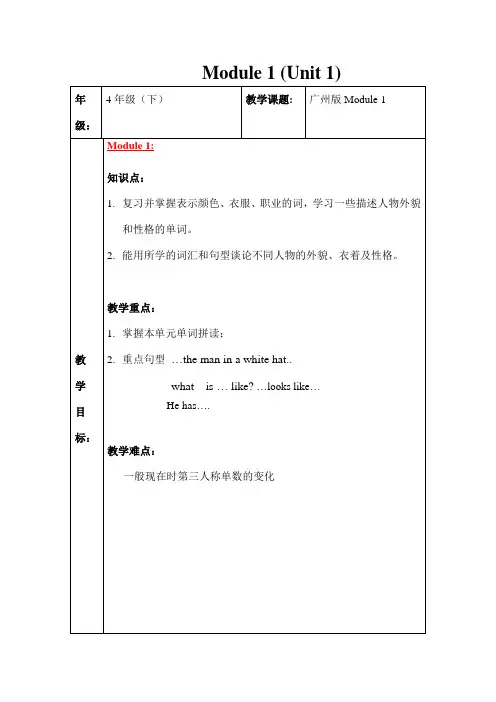
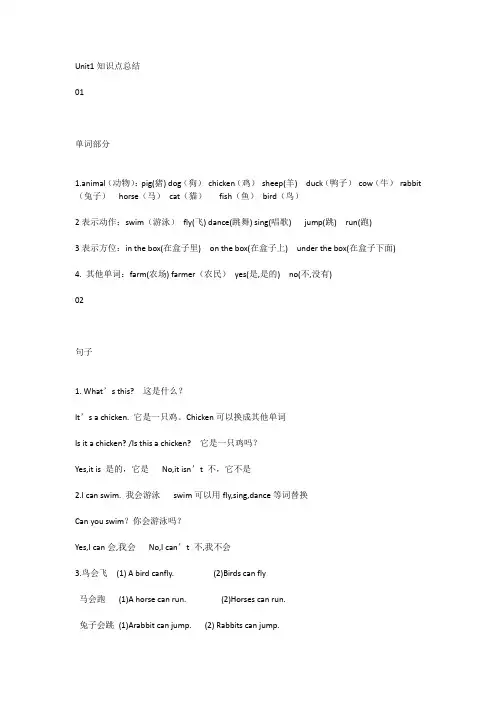
Unit1知识点总结01单词部分1.animal(动物):pig(猪) dog(狗)chicken(鸡)sheep(羊) duck(鸭子)cow(牛)rabbit (兔子)horse(马)cat(猫)fish(鱼)bird(鸟)2表示动作:swim(游泳)fly(飞) dance(跳舞) sing(唱歌) jump(跳) run(跑)3表示方位:in the box(在盒子里) on the box(在盒子上) under the box(在盒子下面)4. 其他单词:farm(农场) farmer(农民)yes(是,是的) no(不,没有)02句子1. What’s this? 这是什么?It’s a chicken. 它是一只鸡。
Chicken可以换成其他单词Is it a chicken? /Is this a chicken? 它是一只鸡吗?Yes,it is 是的,它是No,it isn’t 不,它不是2.I can swim. 我会游泳swim可以用fly,sing,dance等词替换Can you swim?你会游泳吗?Yes,I can会,我会No,I can’t 不,我不会3.鸟会飞(1) A bird canfly. (2)Birds can fly马会跑(1)A horse can run. (2)Horses can run.兔子会跳(1)Arabbit can jump. (2) Rabbits can jump.鱼会游泳Fishcan swim.4.A horse can run.马会跑Can a horse run? 马会跑吗?Yes, it can 会,它会No,it can’t 不,它不会5.What animalscan fly?什么动物会飞?Birds can fly.鸟会飞What animals can swim?什么动物会游泳?Fish can swim. 鱼会游泳Ducksand dogs can swim. 鸭子和狗会游泳。
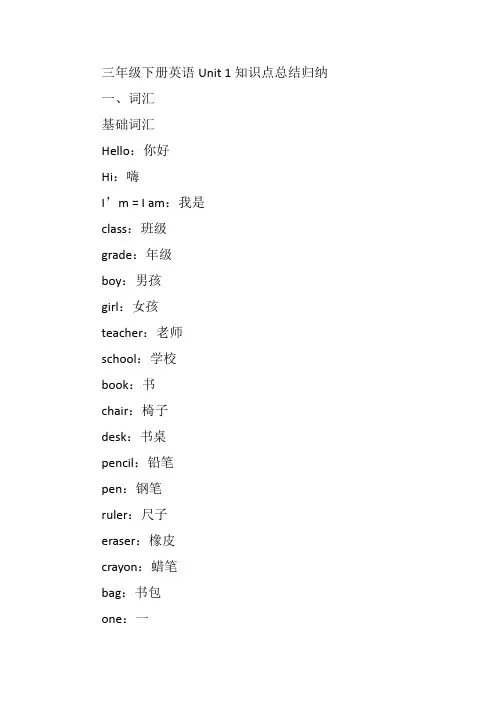
三年级下册英语Unit 1知识点总结归纳一、词汇基础词汇Hello:你好Hi:嗨I’m = I am:我是class:班级grade:年级boy:男孩girl:女孩teacher:老师school:学校book:书chair:椅子desk:书桌pencil:铅笔pen:钢笔ruler:尺子eraser:橡皮crayon:蜡笔bag:书包one:一two:二three:三four:四five:五six:六自我介绍相关词汇My name is…:我的名字是……Your name:你的名字Nice to meet you.:很高兴见到你。
Nice to meet you, too.:我也很高兴见到你。
物品数量描述词汇How many…?:多少……?This one / That one:这个/那个二、句型问候与自我介绍Hello! / Hi! 你好!/ 嗨!Hello, I’m [名字]. 你好,我是[名字]。
Hi, [名字]. 你好,[名字]。
Nice to meet you. 很高兴见到你。
Nice to meet you, too. 我也很高兴见到你。
询问与回答What’s your name? 你叫什么名字?My name is [名字]. 我的名字是[名字]。
What class are you in? 你在哪个班级?I’m in Class [班级号], Grade [年级号]. 我在[年级号]年级[班级号]班。
How many [物品] do you have? 你有多少[物品]?I have [数量] [物品]. 我有[数量]个[物品]。
描述物品This is a [物品]. 这是一个[物品]。
That is a [物品]. 那是一个[物品]。
This one is [颜色] / [大小]. 这个[颜色] / [大小]。
That one is [颜色] / [大小]. 那个[颜色] / [大小]。
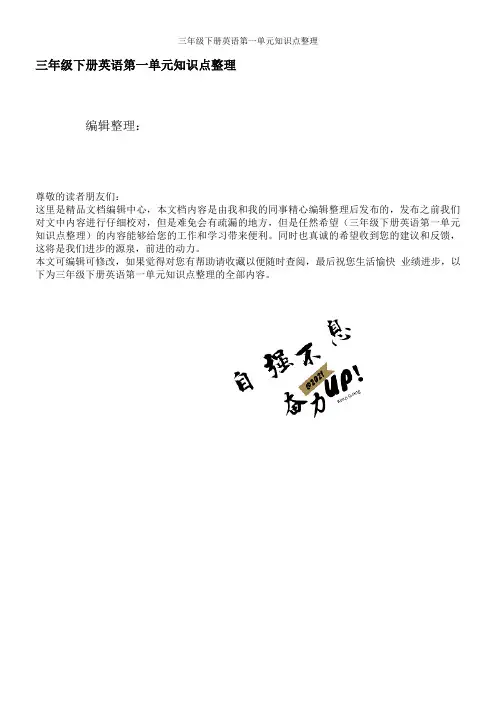
三年级下册英语第一单元知识点整理编辑整理:尊敬的读者朋友们:这里是精品文档编辑中心,本文档内容是由我和我的同事精心编辑整理后发布的,发布之前我们对文中内容进行仔细校对,但是难免会有疏漏的地方,但是任然希望(三年级下册英语第一单元知识点整理)的内容能够给您的工作和学习带来便利。
同时也真诚的希望收到您的建议和反馈,这将是我们进步的源泉,前进的动力。
本文可编辑可修改,如果觉得对您有帮助请收藏以便随时查阅,最后祝您生活愉快业绩进步,以下为三年级下册英语第一单元知识点整理的全部内容。
三年级下册英语第一单元知识点整理1.核心单词open 开,打开 the 这个;这些;那个;那些door 门 close 关上;合上window 窗,窗户 book 书blackboard 黑板don’t=do not 不要2.必备短语in class 在上课 stand up 起立sit down 坐下 open the book 把书打开close the book 把书合上 look at。
.。
看.。
listen to。
.. 听。
come in 进来3.必备句型(1)Good morning, class。
早上好,同学们。
(2)Please open the door。
请把门打开。
(3)I’m sorry, Mr Green。
对不起,格林先生。
(4)Come in, Mike. 进来,Mike。
(5)Look at the blackboard, Sam。
看黑板,Sam。
(6)-—What’s this? -—It’s a robot. —-这是什么?--这是一个机器人。
(7)Don't listen to the parrot, Sam! 不要听鹦鹉的话,Sam。
4.实用句型(1)Bob has two big, big books。
Bob有两本大大的书。
(2)Open your book and say “Hello!” 把你的书打开,说“你好!"(3)Close your book and off we go! 把你的书合上,我们走吧!5.核心语法Please open/close。
Module 1 Colours
第一讲I like red
教学目标:
1、能听、说、读、写单词:blue, white, red, yellow, colour等;
2、能运用颜色修饰事物,如:a blue car,a red kite等;
3、能运用询问颜色的句子及其回答。
一、看中文写单词。
1. 2. 3.
红色;红色的白色;白色的颜色
4. 5. 6.
去到……喜欢
7. 8. 9.
蓝色;蓝色的好极了;太好了黄色;黄色的
二、看中文写短语。
1. 2.
一辆蓝色的小汽车一架白色的飞机
3. 4.
一艘黄色的小船一个红色的球
5. 6.
三、看中文写句子。
1.
---它是什么颜色的? ---它是白色的。
2.
---Janet, 让我们去玩吧! ---好的。
3.
---太好了,我喜欢红色。
4.
---我有一只黄色的风筝。
5.
---好主意。
四、选择一个不同类的单词。
( ) 1. A. green B. orange C. ball
( ) 2. A. black B. colour C. white
( ) 3. A. pink B. apple C. kite
( ) 4. A. idea B. yellow C. black
( ) 5. A. look B. go C. purple
五、仿造例句,完成对话。
---I have a __kite_______. ---What colour is it?
---It’s ___red_____.
---Do you like ___red_____? ---Yes, I ___________.---I have a __________.
---What colour is it?
---It’s ___________.
---Do you like ________?
---No, I ___________.
---I have a __________.
---What colour is it?
---It’s ___________.
---Do you like ________?
---Yes, I ___________.
五、选择一个最佳的答案,并把其编号写在题前的括号里。
(10分)( )1.A: ______ are you? B: I’m fine. A. What B. How C. Where
( )2. ______ colour the hat red. A. Let B. Let’s C. What’s
( )3. I ______ a kite. A. have B. is C. am
( )4. A: Do you like blue? B: Yes, I ______. A. don’t B. am C. do
( )5. A: Let’s colour it orange. B: _______ A. OK B. Let us. C. Thanks. ( )6. Look ______ the picture. A. on B. in C. at
( )7. A: Is it in the box? B: No it ______ A. is B. isn’t C. don’t
( )8. A: ______ colour is the cat? B: It’s black. A. What B. Where C. How ( )9. A; ______ is the doll? B: It’s in the box. A. What B. Where C. How ( )10. A: Let’s go to play. B: Good ______. A. OK B. idea C. morning 六、看图,选择与图意一致的句子。
( ) 1. A. --Is this a ball? --No, it isn’t. B. --Is this a ball? --Yes, it is.
C. --Is this a kite? --Yes, it is.
( ) 2. A. --This is a white bag. B. --This isn’t a white bag.
C. --This is a green bag.
( ) 3. A. --What colour is the bed? -- It is red.
B. --What colour is the bag? --It is white.
C. --What colour is the bed? --It is white.
( ) 4. A.-- Is it a yellow picture? --No, it isn’t.
B. --Is it a yellow picture? --Yes, it is.
C. --Is it a white picture? --No, it isn’t.
( ) 5. A. It is a white car. B. It is a white bus. C. It isn’t a white car.
七、按要求涂颜色:
Let’s colour the hat blue. Let’s colour the nose yellow. Let’s colour the hair red. Let’s colour the mouth green. Let’s colour the eyes orange. Let’s colour the face purple.。